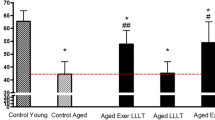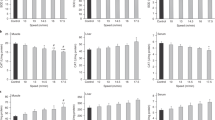Abstract
The aim of the present study was to determine whether low-level laser therapy (LLLT) in conjunction with aerobic training interferes with oxidative stress, thereby influencing the performance of old rats participating in swimming. Thirty Wistar rats (Norvegicus albinus) (24 aged and six young) were tested. The older animals were randomly divided into aged-control, aged-exercise, aged-LLLT, aged-LLLT/exercise, and young-control. Aerobic capacity (VO2max0.75) was analyzed before and after the training period. The exercise groups were trained for 6 weeks, and the LLLT was applied at 808 nm and 4 J energy. The rats were euthanized, and muscle tissue was collected to analyze the index of lipid peroxidation thiobarbituric acid reactive substances (TBARS), glutathione (GSH), superoxide dismutase (SOD), and catalase (CAT) activities. VO2 0.75max values in the aged-LLLT/exercise group were significantly higher from those in the baseline older group (p <0.01) and the LLLT and exercise group (p <0.05). The results indicate that the activities of CAT, SOD, and GPx were higher and statistically significant (p <0.05) in the LLLT/exercise group than those in the LLLT and exercise groups. Young animals presented lesser and statistically significant activities of antioxidant enzymes compared to the aged group. The LLLT/exercise group and the LLLT and exercise group could also mitigate the concentration of TBARS (p > 0.05). Laser therapy in conjunction with aerobic training may reduce oxidative stress, as well as increase VO2 0.75max, indicating that an aerobic exercise such as swimming increases speed and improves performance in aged animals treated with LLLT.





Similar content being viewed by others
References
Wang CH, Wu SB, Wu YT, Wei YH (2013) Oxidative stress response elicited by mitochondrial dysfunction: implication in the pathophysiology of aging. Exp Biol Med (Maywood) 238:450–460
Marzetti E, Calvani R, Cesari M et al (2013) Mitochondrial dysfunction and sarcopenia of aging: from signaling pathways to clinical trials. Int J Biochem Cell Biol 45:2288–2301
Bouzid MA, Hammouda O, Matran R, Robin S, Fabre C (2014) Changes in oxidative stress markers and biological markers of muscle injury with aging at rest and in response to an exhaustive exercise. PLoS One 9, e90420
Lima FD, Stamm DN, Della-Pace ID et al (2013) Swimming training induces liver mitochondrial adaptations to oxidative stress in rats submitted to repeated exhaustive swimming bouts. PLoS One 8, e55668
Powers SK, Ji LL, Leeuwenburgh C (1999) Exercise training-induced alterations in skeletal muscle antioxidant capacity: a brief review. Med Sci Sports Exerc 31:987–997
Souza NH, Marcondes PT, Albertini R, Mesquita-Ferrari RA, Fernandes KP, Aimbire F. Low-level laser therapy suppresses the oxidative stress-induced glucocorticoids resistance in U937 cells: Relevance to cytokine secretion and histone deacetylase in alveolar macrophages. J Photochem Photobiol B 2013;(26)130C:327-336.
Alves AC, Vieira R, Leal-Junior E et al (2013) Effect of low-level laser therapy on the expression of inflammatory mediators and on neutrophils and macrophages in acute joint inflammation. Arthritis Res Ther 15:R116
Laraia EM, Silva IS, Pereira DM et al (2012) Effect of low-level laser therapy (660 nm) on acute inflammation induced by tenotomy of Achilles tendon in rats. Photochem Photobiol 88:1546–1550
Sussai DA, Carvalho Pde T, Dourado DM, Belchior AC, dos Reis FA, Pereira DM (2010) Low-level laser therapy attenuates creatine kinase levels and apoptosis during forced swimming in rats. Lasers Med Sci 25:115–120
De Marchi T, Leal Junior EC, Bortoli C, Tomazoni SS, Lopes-Martins RA, Salvador M (2012) Low-level laser therapy (LLLT) in human progressive-intensity running: effects on exercise performance, skeletal muscle status, and oxidative stress. Lasers Med Sci 27:231–236
Antonialli FC, De Marchi T, Tomazoni SS, et al (2014) Phototherapy in skeletal muscle performance and recovery after exercise: effect of combination of super-pulsed laser and light-emitting diodes. Lasers Med Sci 29: 1967–1976
Leal Junior EC, Lopes-Martins RA, Frigo L et al (2010) Effects of low-level laser therapy (LLLT) in the development of exercise-induced skeletal muscle fatigue and changes in biochemical markers related to postexercise recovery. J Orthop Sports Phys Ther 40:524–532
Leal Junior EC, Lopes-Martins RA, Dalan F et al (2008) Effect of 655-nm low-level laser therapy on exercise-induced skeletal muscle fatigue in humans. Photomed Laser Surg 26:419–424
Leal-Junior EC, Vanin AA, Miranda EF et al (2015) Effect of phototherapy (low-level laser therapy and light-emitting diode therapy) on exercise performance and markers of exercise recovery: a systematic review with meta-analysis. Lasers Med Sci 30:925–939
Santos LA, Marcos RL, Tomazoni SS, et al (2014) Effects of pre-irradiation of low-level laser therapy with different doses and wavelengths in skeletal muscle performance, fatigue, and skeletal muscle damage induced by tetanic contractions in rats. Lasers Med Sci 29:1617–1626
Amadio EM, Serra AJ, Guaraldo SA, et al (2015) The action of pre-exercise low-level laser therapy (LLLT) on the expression of IL-6 and TNF-α proteins and on the functional fitness of elderly rats subjected to aerobic training. Lasers Med Sci 30:1127–1134
AVMA Panel on Euthanasia. American Veterinary Medical Association (2001) 2000 Report of the AVMA Panel on Euthanasia. J Am Vet Med Assoc 218:669–696. Erratum in: J Am Vet Med Assoc 218:1884
Vieira Junior Roberto Carlos, Silva Carolina Mendes Santos, Araújo Michel Barbosa de, Garcia Alesandro, Voltarelli Vanessa Azevedo, Reis Filho Adilson Domingos. Aerobic swimming training increases the activity of antioxidant enzymes and the glycogen content in the skeletal muscle of rats. Rev Bras Med Esporte 2014;19:204–208.
Palazzetti S, Richard MJ, Favier A, Margaritis I (2003) Overloaded training increases exercise-induced oxidative stress and damage. Can J Appl Physiol 28:588–604
Alessio HM, Hagerman AE, Fulkerson BK, Ambrose J, Rice RE, Wiley RL (2000) Generation of reactive oxygen species after exhaustive aerobic and isometric exercise. Med Sci Sports Exerc 32:1576–1581
Richardson RS, Tagore K, Haseler LJ, Jordan M, Wagner PD (1998) Increased VO2 max with right-shifted Hb-O2 dissociation curve at a constant O2 delivery in gog muscle in situ. J Appl Physiol 84:995–1002
Moffatt SE, Bearden RJ (2000) VO2 Kinetics and the O2 deficit in heavy exercise. J Appl Physiol 88:407–1412
Fletcher GF, Balady GJ, Amsterdan EA et al (2001) Exercise standards for testing and training: A statement for healthcare professionals from the American Heart Association. Circulation 104:1694–1740
Ogawa T, Spina RJ, Martin WH et al (1992) Effects of aging, sex, and physical training on cardiovascular responses to exercise. Circulation 86:494–503
Biasibetti M, Rojas DB, Hentschke VS et al (2014) The influence of low-level laser therapy on parameters of oxidative stress and DNA damage on muscle and plasma in rats with heart failure. Lasers Med Sci 29:1895–906
Fillipin LI, Mauriz JL, Vedovelli K et al (2005) Low-level laser therapy (LLLT) prevents oxidative stress and reduces fibrosis in rat traumatized Achilles tendon. Lasers Surg Med 37:293–300
Ferraresi C, Hamblin MR, Parizotto NA (2012) Low-level laser (light) therapy (LLLT) on muscle tissue: performance, fatigue and repair benefited by the power of light. Photonics Lasers Med 1:267–286
da Fonseca Ade S, Presta GA, Geller M, de Paoli F, Valença SS (2012) Low-intensity infrared laser increases plasma proteins and induces oxidative stress in vitro. Lasers Med Sci 27:211–217
Acknowledgments
Professor Paulo de Tarso Camillo de Carvalho thanks the Brazilian Research Council-CNPq for the Research Productivity Scholarship (Process no.307665/2012-7).
Author information
Authors and Affiliations
Corresponding author
Ethics declarations
Conflict of interest
No competing financial interests exist. Professor Ernesto Cesar Pinto Leal-Junior receives research support from Multi Radiance Medical (Solon, OH-USA), a laser device manufacturer. Multi Radiance Medical had no role in the planning of this study, and the laser device used was not theirs. They had no influence on study design, data collection and analysis, decision to publish, or preparation of the manuscript. The remaining authors declare that they have no conflict of interests.
Rights and permissions
About this article
Cite this article
Guaraldo, S.A., Serra, A.J., Amadio, E.M. et al. The effect of low-level laser therapy on oxidative stress and functional fitness in aged rats subjected to swimming: an aerobic exercise. Lasers Med Sci 31, 833–840 (2016). https://doi.org/10.1007/s10103-016-1882-2
Received:
Accepted:
Published:
Issue Date:
DOI: https://doi.org/10.1007/s10103-016-1882-2




